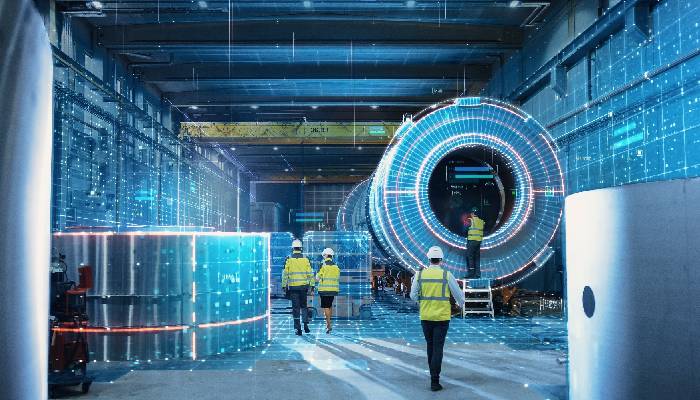In the evolving Industry 4.0 era, the manufacturing sector, long rooted in traditional processes and practices, is undergoing a profound revolution driven by digital transformation.
Advanced technologies like IoT, AI and automation enable smart factories, real-time supply chain visibility and data-driven efficiency improvements. They streamline operations and unlock unprecedented innovation, efficiency, and sustainability opportunities. According to a recent report, manufacturing firms’ worldwide spend on digital transformation will reach $4.07 billion by 2033, with a CAGR of 21.2% from 2023-2033.
For manufacturing CIOs, this disruption brings both opportunity and risk. It requires them to expand beyond managing IT infrastructure and be pivotal in steering the course of this transformation. The shift in responsibilities necessitates a deep understanding of the industry’s unique challenges and the ability to harness technological advancements to address them for greater market agility and adaptability.
“CIOs who embrace their role as digital leaders will be instrumental in leading their manufacturing businesses successfully into the future.”
Top 5 Actionable Insights for CIOs
#1 IoT and Smart Factory Technologies
Industrial IoT, powered by sensors, connectivity, and cloud platforms, provides the foundation for smart manufacturing. IoT-enabled equipment and assets generate data for monitoring, analytics, and machine learning, driving predictive maintenance. IoT tools like condition monitoring, dynamic scheduling, computer vision inspection and sensor network data can deliver significant efficiency and quality gains.
#2 Real-Time Supply Chain Visibility through Data Intelligence
Connecting the data across production, inventory, logistics and partners enables manufacturers to gain end-to-end supply chain visibility. Combining IoT, ERP/MRP systems, logistics data and advanced analytics provides real-time insight into operations, enabling faster decisions and agility. Advanced analytics and AI in supply chain data help identify inefficiencies, improve forecasts, and optimize inventory and logistics.
#3 Cybersecurity for Critical Operational Systems
Cybersecurity is a priority for operational technology as connected equipment and converged IT/OT networks can create new cyber risks. Therefore, robust identity and access controls for equipment access are essential. Monitoring, encryption, and malware protection must be deployed on shop floors along with safety shutdown procedures in case of compromise to hedge risks.
#4 Analytics and AI for Improved Quality and Efficiency
Advanced analytics and artificial intelligence unlock major performance gains across production quality, uptime, and throughput. With vast operational data, machine learning algorithms optimize processes, predict failures, and customize maintenance. Computer vision helps automate inspection, and virtual sensors enhance monitoring. But AI success requires clean, well-organized data flows.
#5 Workforce Skills in Digital Technologies such as Automation and ML
As technology redefines roles across production facilities, workers need retraining in data analytics, programming, robotics, and information security. Planning workforce evolution for the digital factory is crucial. CIOs must conduct skills gap analyses and develop training programs, leveraging internal experts and external partners. Reskilling veteran employees while integrating digital-native workers will maximize knowledge transfer. However, organizational change management is critical, as automation may displace some long-term staff.
Navigating Challenges and Risks
Transitioning to a digital manufacturing environment poses multiple technological and organizational hurdles that CIOs must be prepared to address. These include:
Technology Integration Complexities
With numerous legacy machines and systems already in place, connecting new digital infrastructure like IoT sensors, networks and cloud platforms can be enormously challenging. CIOs must take an architectural approach, developing detailed integration roadmaps and carefully sequenced implementation phases, prioritizing use cases and identifying integration dependencies.
Organizational Change Management
As new technologies fundamentally reshape roles and workflows, workers may resist technologies like advanced automation and AI that alter their functions. CIOs play a leading role in change management through clear communication, reskilling support and demonstrating benefits.
Retraining the Workforce
CIOs must focus on extensive workforce training in new digital competencies like data analytics, robotics operations and cybersecurity, which are essential for a successful transformation. These initiatives require substantial investments in learning programs.
Securing Connected Operational Environments
With increased connectivity between IT and OT systems, enlarged attack surfaces and more data flows, improving cybersecurity protections across operational environments is crucial. Implementing tailored identity and access controls, network segmentation, monitoring and security controls tailored to smart factory environments is imperative.
Key Strategic Initiatives
Navigating the digital transformation journey requires CIOs to focus on several strategic initiatives, such as:
Collaborating with Operations Leaders
CIOs must partner with COOs and production leads to drive digital manufacturing success when developing automation, analytics, and AI plans. It ensures alignment with operational priorities and integration with legacy systems.
Architecting Secure IT/OT Convergence
CIOs must architect smart, secure network infrastructures connecting IT and OT environments. It includes network segmentation, identity management and access controls.
Cybersecurity for OT
Conducting in-depth assessments of cybersecurity protections for industrial control systems and connected manufacturing equipment. Identify gaps and upgrade controls like monitoring, access management and malware prevention to mitigate growing OT risks.
Workforce Reskilling and Organizational Change
CIOs are central to organizational change management as new technologies transform workflows, roles, and culture. They must plan and deliver extensive workforce training programs to reskill employees on data analytics, robotics, and information security technologies.
Building the Business Case
Building detailed business cases quantifying the ROI of digital investments through increased efficiency, quality gains, reduced downtime, and supply chain optimization.
Redefining Manufacturing Operations
As Digital transformation redefines manufacturing operations, partnering with technology and digital solutions providers such as TTBS can help CIOs leverage emerging technologies and enable their organizations to maximize efficiency, quality, and competitiveness. However, managing complex integrations, evolving workforces, organizational change, and cybersecurity will require deft leadership and collaboration with operational leaders. CIOs who embrace their role as digital leaders will be instrumental in leading their manufacturing businesses successfully into the future. With careful planning and execution, the smart factories of tomorrow are becoming a reality, driving paradigm operational shifts for success.
For more information , please click https://www.tatatelebusiness.com/experience-zone/it-ites/




